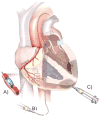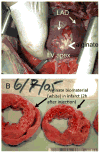Materials science and tissue engineering: repairing the heart
- PMID: 23910415
- PMCID: PMC3786696
- DOI: 10.1016/j.mayocp.2013.05.003
Materials science and tissue engineering: repairing the heart
Abstract
Heart failure after a myocardial infarction continues to be a leading killer in the Western world. Currently, there are no therapies that effectively prevent or reverse the cardiac damage and negative left ventricular remodeling process that follows a myocardial infarction. Because the heart has limited regenerative capacity, there has been considerable effort to develop new therapies that could repair and regenerate the myocardium. Although cell transplantation alone was initially studied, more recently, tissue engineering strategies using biomaterial scaffolds have been explored. In this review, we cover the different approaches to engineering the myocardium, including cardiac patches, which are in vitro-engineered constructs of functional myocardium, and injectable scaffolds, which can either encourage endogenous repair and regeneration or act as vehicles to support the delivery of cells and other therapeutics.
Keywords: ECM; EHT; ESC; HA; LV; MI; MeHA; PSC; VEGF; bFGF; basic fibroblast growth factor; embryonic stem cell; engineered heart tissue; extracellular matrix; hESC; human embryonic stem cell; hyaluronic acid; iPSC; induced pluripotent stem cell; left ventricular; methacrylated hyaluronic acid; myocardial infarction; pluripotent stem cells; vascular endothelial growth factor.
Copyright © 2013 Mayo Foundation for Medical Education and Research. Published by Elsevier Inc. All rights reserved.
Figures






References
-
- Beltrami AP, Barlucchi L, Torella D, Baker M, Limana F, Chimenti S, Kasahara H, Rota M, Musso E, Urbanek K, Leri A, Kajstura J, Nadal-Ginard B, Anversa P. Adult cardiac stem cells are multipotent and support myocardial regeneration. Cell. 2003;114(6):763–776. - PubMed
-
- Messina E, De Angelis L, Frati G, Morrone S, Chimenti S, Fiordaliso F, Salio M, Battaglia M, Latronico MV, Coletta M, Vivarelli E, Frati L, Cossu G, Giacomello A. Isolation and expansion of adult cardiac stem cells from human and murine heart. Circ Res. 2004;95(9):911–921. - PubMed
-
- Schoen FJ. Heart valve tissue engineering: Quo vadis? Curr Opin Biotechnol. 2011;22(5):698–705. - PubMed
Publication types
MeSH terms
Grants and funding
LinkOut - more resources
Full Text Sources
Other Literature Sources
Medical

